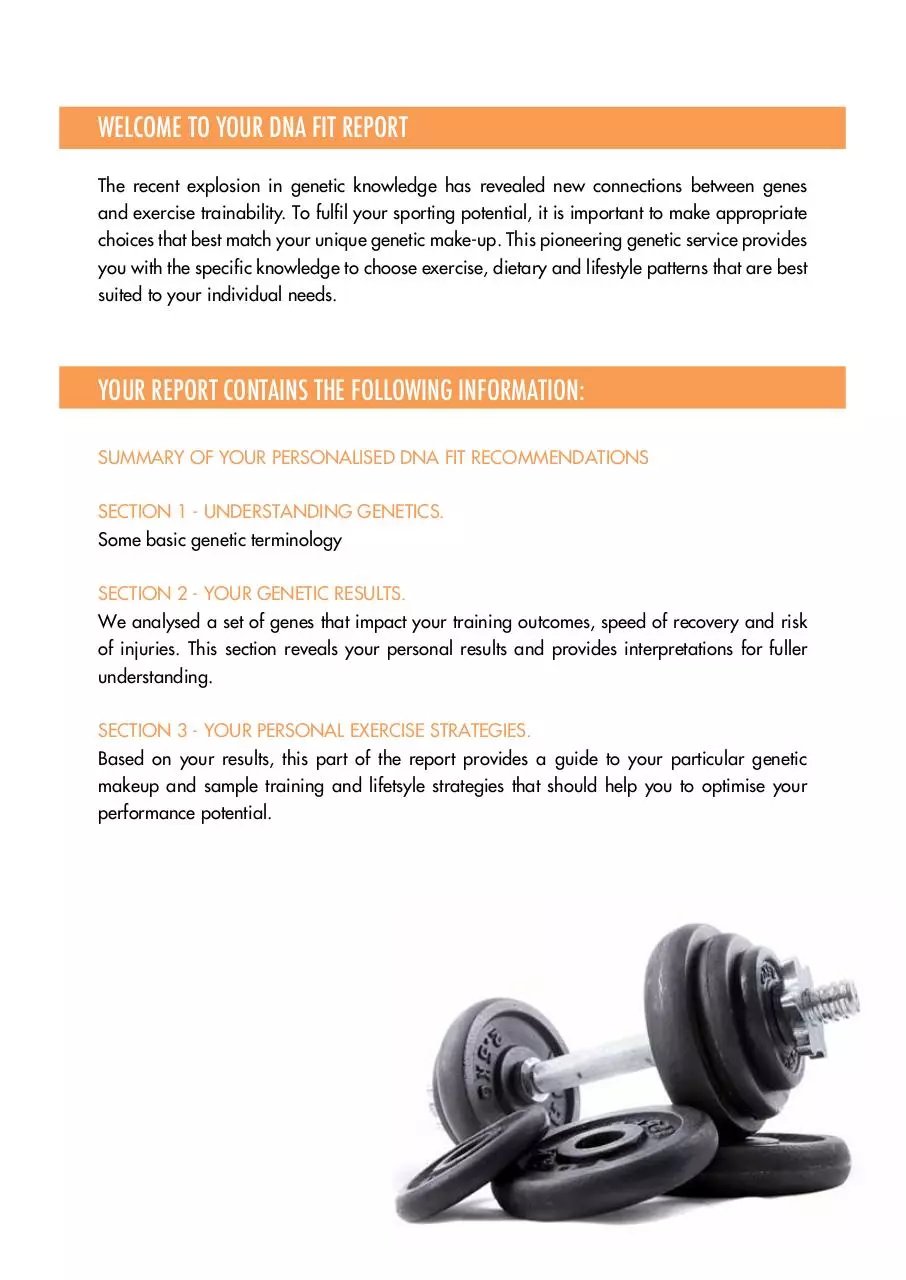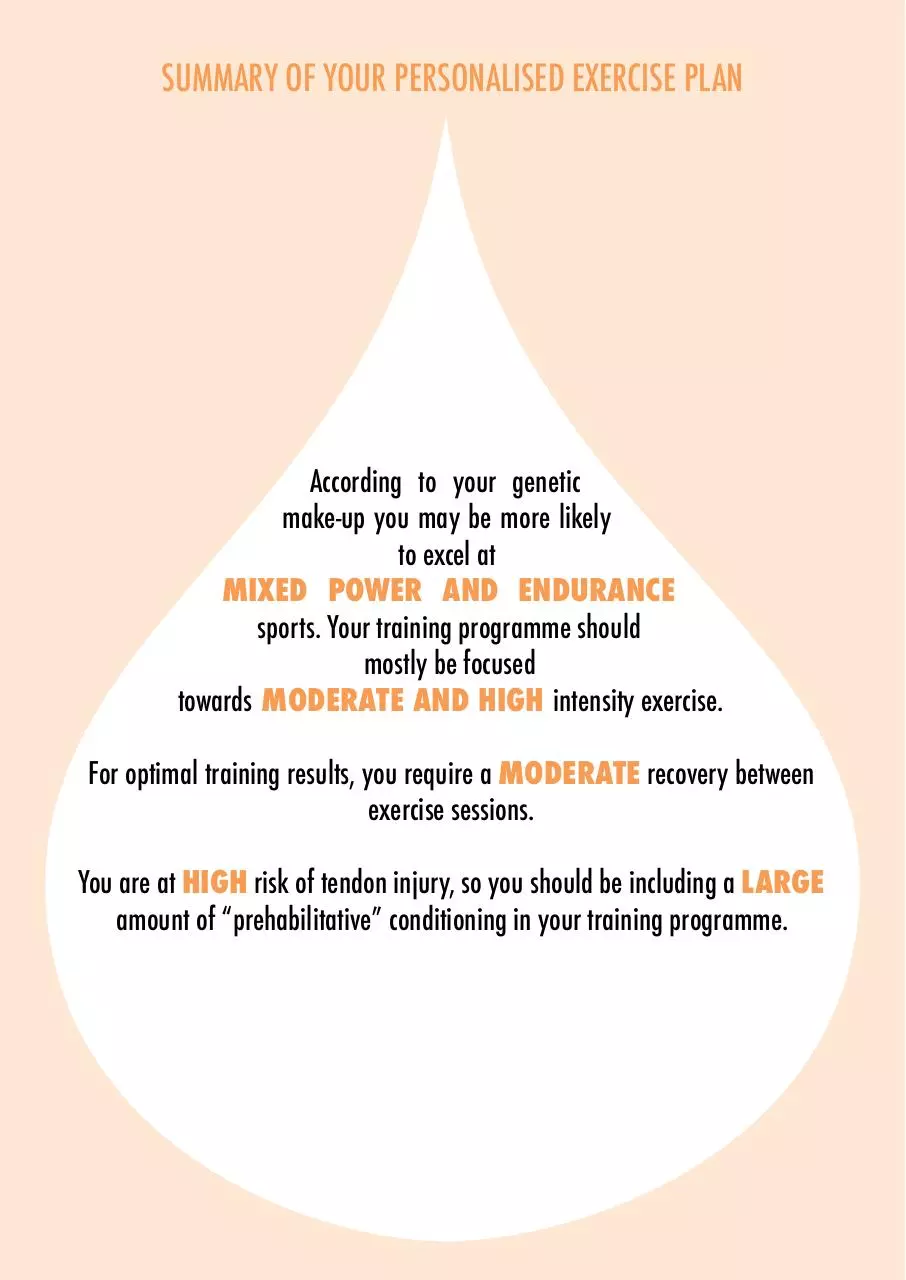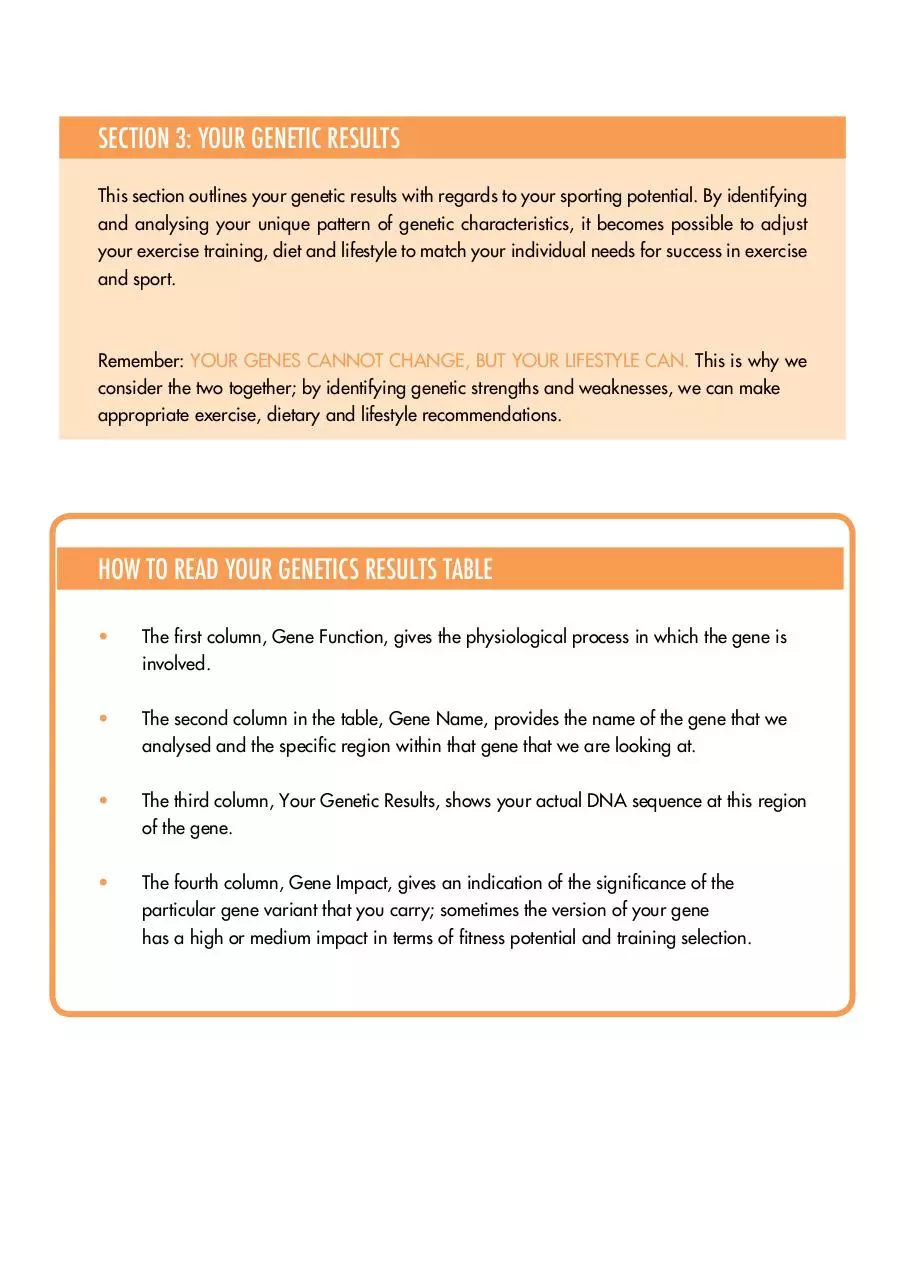DNA Fit Report (PDF) Sample (PDF)
File information
This PDF 1.5 document has been generated by Adobe InDesign CS5 (7.0) / PDF Annotator 3.0.0.336 [Adobe PDF Library 9.9], and has been sent on pdf-archive.com on 26/05/2014 at 18:49, from IP address 91.75.x.x.
The current document download page has been viewed 2330 times.
File size: 1.25 MB (22 pages).
Privacy: public file





File preview
optimal sport for life
GENOTYPE REPORT
Patient Name:
Date of Birth:
Sample Number:
Referring Practitioner:
Date Reported:
WELCOME TO YOUR DNA FIT REPORT
The recent explosion in genetic knowledge has revealed new connections between genes
and exercise trainability. To fulfil your sporting potential, it is important to make appropriate
choices that best match your unique genetic make-up. This pioneering genetic service provides
you with the specific knowledge to choose exercise, dietary and lifestyle patterns that are best
suited to your individual needs.
YOUR REPORT CONTAINS THE FOLLOWING INFORMATION:
SUMMARY OF YOUR PERSONALISED DNA FIT RECOMMENDATIONS
SECTION 1 - UNDERSTANDING GENETICS.
Some basic genetic terminology
SECTION 2 - YOUR GENETIC RESULTS.
We analysed a set of genes that impact your training outcomes, speed of recovery and risk
of injuries. This section reveals your personal results and provides interpretations for fuller
understanding.
SECTION 3 - YOUR PERSONAL EXERCISE STRATEGIES.
Based on your results, this part of the report provides a guide to your particular genetic
makeup and sample training and lifetsyle strategies that should help you to optimise your
performance potential.
SUMMARY OF YOUR PERSONALISED EXERCISE PLAN
According to your genetic
make-up you may be more likely
to excel at
MIXED POWER AND ENDURANCE
sports. Your training programme should
mostly be focused
towards MODERATE AND HIGH intensity exercise.
For optimal training results, you require a MODERATE recovery between
exercise sessions.
You are at HIGH risk of tendon injury, so you should be including a LARGE
amount of “prehabilitative” conditioning in your training programme.
SECTION 2: UNDERSTANDING GENETICS
Before reading your full assessment, please take a few minutes to review this background
information which will help you to better understand your results and enhance the overall
value you receive from the information contained in this personalised report.
WHAT ARE GENES?
A gene is a segment of the DNA (short for deoxyribonucleic acid) molecule that contains
the instructions for how, when and where your body makes each of the many thousands of
proteins required for life. Each gene is comprised of thousands of combinations of four letters
that make up your genetic code: A,T, C, and G. Each gene’s code combines the “letters” A, T,
C, and G in various ways, spelling out the “words” that specify which amino acid is needed
at every step in the process of making the proteins required for your body to develop and
function. Increasingly, your genes can also tell you whether you are predisposed to specific
health risks.
WHAT ARE GENE VARIATIONS?
With the exception of identical twins, all people have small differences in the information that
their DNA contains and it’s these differences that make each of us unique. Gene variations are
slight changes in the genetic code that are present in at least one percent of the population.
For example, one genetic “letter” (A, T, C, or G) may be replaced by another. These variations
can lead to different processes in the body, just as altering one letter in a word can completely
change its meaning; for instance, from “g”oat to “c”oat. When the variation affects only one
genetic letter, as in the goat/coat example above, it is called a “single nucleotide polymorphism”
(or SNP, pronounced “snip”).
ARE GENE VARIATIONS “BAD”?
For a given population, one genetic code for a given gene may be found more frequently
than other genetic codes for that same gene. The genetic codes for those genes that appear
less frequently are referred to as “variants”. Variations should not be thought of as “good” or
“bad,” rather, genetic variations are simply the differences in the forms of the genes present
in our bodies. The key is to know which form of the gene you carry, so that you can make diet
and lifestyle choices to reduce your health risks.
WHAT IS NUTRIGENETICS?
Nutrigenetics is concerned with the effects of our individual genetic variations in response to
our diet, exercise and lifestyle, all of which can cause the genes to be “expressed” in a positive
or negative way. Nutrigenetics testing enables us to identify where we are on our journey
towards achieving our individual, optimal health potential.
SECTION 3: YOUR GENETIC RESULTS
This section outlines your genetic results with regards to your sporting potential. By identifying
and analysing your unique pattern of genetic characteristics, it becomes possible to adjust
your exercise training, diet and lifestyle to match your individual needs for success in exercise
and sport.
Remember: Your genes cannot change, but your lifestyle can. This is why we
consider the two together; by identifying genetic strengths and weaknesses, we can make
appropriate exercise, dietary and lifestyle recommendations.
HOW TO READ YOUR GENETICS RESULTS TABLE
•
The first column, Gene Function, gives the physiological process in which the gene is
involved.
•
The second column in the table, Gene Name, provides the name of the gene that we
analysed and the specific region within that gene that we are looking at.
•
The third column, Your Genetic Results, shows your actual DNA sequence at this region
of the gene.
•
The fourth column, Gene Impact, gives an indication of the significance of the
particular gene variant that you carry; sometimes the version of your gene
has a high or medium impact in terms of fitness potential and training selection.
POWER AND ENDURANCE
Some individuals are better suited to running marathons, while others can cover 100m extremely quickly or hoist large weights over their heads with apparent ease. How successful you
become in your chosen sport is to a large degree determined by your genetic makeup. We all
have the potential to attain more success in one sporting event compared to another; it’s just
a case of finding out which one!
The DNA Fit genetic test includes 13 genetic variants associated with power and endurance.
On Page 8 of this report, we provided you with a Power-Endurance scale which gives you a
fair indication of where you should concentrate your efforts.
Gene
Function
GENE
NAME
Your Genetic
Results
AGT
ACE
VEGF
BDRKB
ACTN3
ADRB2 Arg16Gly
Power and
Endurance
ADRB2 Gln27Glu
NRF-2
PPARGC1A
PPARA
TRHR
VDR
IL-6
Low Impact
Medium Impact
High Impact
GENE IMPACT
Endurance
Power
Potential
6
16
22
0.27
YOUR Power & Endurance potential
69%
Power Potential
Endurance Potential
31%
Endurance Potential
6
16
Your genetic results indicate that you have a mixture of Power and Endurance traits. This
22
means
0.27 that you are most suited to activities that require a strong endurance base to last the
Performance Potential
duration of the event, while being able to sustain a high energy output or being able to rapidly
change pace to respond to the needs of the event. Your physiology means that you are likely
100%
to do both extreme power and 69%
endurance events moderately well. Energetically, you will
80%
the two energy systems together,
60%be exercising “aerobically” and “anaerobically”; by using
Total Athlete Power Potential
of time or alternate
40%you can operate at a moderately intense level for a moderate duration
Endurance Potential
20%between high and low intensities for a more prolonged period.
31%
0%
Power Potential
Endurance Potential
your athletic Potential
Performance Potential
100%
80%
60%
Total
Athlete
40%
20%
0%
Power Potential
Endurance Potential
The performance potential graph gives an indication of your genetic “score” as a percentage
of total power and endurance points available. The dotted lines represent the average scores
of all samples tested to date, including some elite athletes; See how you compare?
Key training principles
It appears from your genetic results that you have a mixed power/endurance profile. Your
gene results indicate that you will be best at and attain greatest training returns from a mixture
of endurance- and power-based exercise. This means that you are most suited to activities that
make use of both short- and long-duration energy systems. Events that you might excel in can
be dived into two categories: 1) Middle-distance events such as running, cycling, swimming,
canoeing, rowing and triathlon; and 2) Intermittent Sprint events such as team sports like
football, rugby, hockey, basketball; court games like tennis, badminton and squash; and
combat sports like boxing, wrestling and martial arts. Your training should therefore include a
broad range of exercise activities, including moderate- and high-intensity endurance training,
strength & conditioning and speed & power training.
If you are involved in a specific sport, then your training should be tailored to the needs of
that sport. For example, if you are a hockey or rugby player, the position that you play in
should involve a mixture of endurance and power/speed moves. You are most likely to benefit
from a moderate volume of training; some moderate-intensity endurance and some highintensity speed, strength and power training, which should be incorporated into your schedule
alongside your sport-specific training.
If you are involved in an endurance sport, such as running, cycling or triathlon, be aware that
your strengths most likely lie in the shorter to middle distances such the middle-distance track
races and short-distance road events. Within your current training programme, depending
on time available and training background, aim to stimulate your aerobic energy systems 3-4
days per week and anaerobic energy systems (power, strength, speed) 2-3 days per week.
If you exercise simply to keep fit and look in good shape, you are most likely to obtain good
returns for your efforts with a mixture of training intensities. Include weight training, speed
and power work and moderate-duration endurance efforts. An important training system for
you is interval training, which is performed at the higher intensities of endurance training
and strongly stimulates lactate threshold and VO2max, two important variables in exercise
science.
What follows are some sample training programmes for a variety of exercise activities. As
someone who has a power potential, we recommend that you focus your efforts on the high
intensity sessions such as Level 5 and above, sprinting and low-repetition resistance training.
Some benefit might be obtained from Olympic lifts and plyometrics depending on your
sporting interests. Your biggest ‘bang for your buck’ training types may be sprinting sessions
and strength- to power-based weight training (low-rep ranges).
Download DNA-Fit-Report Sample
DNA-Fit-Report.pdf Sample.pdf (PDF, 1.25 MB)
Download PDF
Share this file on social networks
Link to this page
Permanent link
Use the permanent link to the download page to share your document on Facebook, Twitter, LinkedIn, or directly with a contact by e-Mail, Messenger, Whatsapp, Line..
Short link
Use the short link to share your document on Twitter or by text message (SMS)
HTML Code
Copy the following HTML code to share your document on a Website or Blog
QR Code to this page

This file has been shared publicly by a user of PDF Archive.
Document ID: 0000165267.